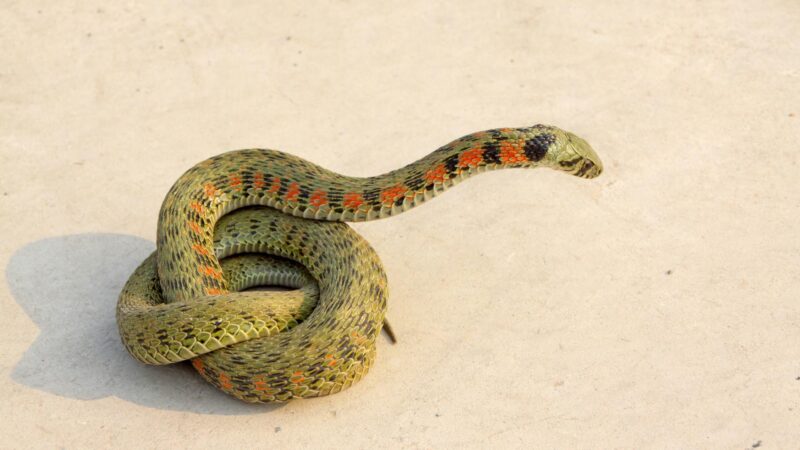The mere idea of seeing a snake is enough to scare people. But what if you spot some animal feces that you are not familiar with? Relying on snake poop images alone will not help you memorize its actual appearance. This is because not all of them look the same.
Snake droppings are mostly long deposits instead of small pellets. They can be light brown, brown, or black and resemble small logs. The excrement of both snakes and rats is oblong. The points of a snake’s excrement often point downward and are mostly white.
Like humans and other animals, snakes digest their food and release waste. If you found snake poop within your property, it does not necessarily mean that you will see another one soon. For your safety and your family, this article will teach you a lot about snake feces.
What Does Snake Poop Look Like?

Snake poop looks like the feces of other animals, such as lizards and birds. Although colors may differ, snake droppings are usually brown, oblong, or in a tube shape, tapered on both sides. Snake poop size depends on the size of the reptile and what it ate last. Snake feces can also be of one piece or several small pieces.
Also called snake scat, snake droppings have two parts – the fecal fragment and the uric acid. Like other animals, snakes also exert urine. Snake poop can be wet when fresh and eventually become dry. In some cases, the urine is solid (white urea cap) that looks like chalk. Like other animal poop, they also have a foul smell.
When Can You Usually See Snake Droppings?
Being ectothermic (cold-blooded) animals, snakes cannot regulate their body temperature internally and demand less energy. Snakes are usually most active between April and October. They don’t hibernate in the winter but rather are less active. Therefore, snake feces appear more often during warmer months or summer.
How Do Snakes Poop and Pee?
Like birds and amphibians, snakes poop and pee through their cloaca, which means “sewer” in Latin. The outer opening is called a vent, which can be found between the snake’s belly and tail. Interestingly, this is also where snakes release their eggs and waste. Snakes also mate through this anal opening.
How Often Do Snakes Poop?
Typically, snakes poop very seldom because they also eat infrequently. The time from ingestion of food to defecation is called gut passage time, which depends on several factors. This includes the size, quality, and texture of the food, eating frequency, gut morphology, temperature, and the health condition of the snake.
As a rule of thumb, a snake that eats once a week will poop once a week. Bush vipers may defecate every 3-7 days only, while rat snakes may poop every two days. Amazingly, 5-20% of the body mass of Gaboon vipers is feces. A study also revealed that some vipers and pythons don’t poop for up to 420 days!
Where Do Snakes Poop?
Snakes poop anywhere they want to, and even in their communal nests. When close to human habitat, they may defecate in gardens, backyards, landscapes, and fences, especially if you have livestock or farm animals. Once they are inside your house, snakes may leave their feces in chimneys, attics, and basements.
How Do Snakes Digest Food?

Snakes eat their prey as a whole, including feathers, teeth, and bones. The food passes through the esophagus until it reaches the stomach. The acid juices will break down the food with the help of their powerful stomach muscles. The food will further be digested in the small intestines, where the nutrients are extracted.
The nutrients will go to the bloodstream and will be distributed to the different parts of the body of the snake. On the other hand, the undigested food will be released and will become poop. Snakes digest their food longer than humans and may last for 4-5 days. It may take longer, though, depending on the food.
Do Snakes Poop Out the Bones of Their Prey?
In general, snakes don’t poop out the bones of their prey. They can also digest teeth, hair, and feathers. But then, some snake feces may contain some bit of bones and teeth. This usually happens when the snake is sick or interrupted after eating. In some cases, snakes may regurgitate their food, including bones.
Related: How to Get Rid of Cottonmouth Snakes? | Effective Techniques and Safety Tips
Snake Feces vs. Regurgitation: What’s the Difference?
Snake feces are sometimes mistaken for regurgitated food, but they are different. It is waste released by the reptile from the vent, while regurgitation is when a snake releases swallowed food through its mouth from its esophagus. Meanwhile, vomiting is the release of food from the stomach.
When a snake regurgitates, the substance ejected includes gastric juices and undigested food such as bones. Snake poop may also include undigested food, including bones if the reptile has digestive problems. Regurgitated food and snake poop are both disgusting to look at, but their appearances are different.
Can Snake Droppings Make You Sick?

Snake droppings can make you sick. Reptiles such as turtles, lizards, and snakes can carry Salmonella bacteria in their digestive tracts. Salmonellosis affects the intestinal tract of reptiles and can be transmitted to humans through direct or indirect contact with the infected animal, their droppings, or the environment.
You may get Salmonellosis once you touch infected snakes and then touch your mouth without washing your hands properly. You can also get infected if you come into contact with contaminated water. Symptoms include stomach cramps, diarrhea, and fever. Snake feces may also contain bacteria, even if the reptile looks healthy.
Do Snakes Poop When Stressed?
Some snakes poop when they are stressed. This usually happens to pet snakes while you are handling them, and they cannot tell you that they prefer being alone. Snakes are also stressed while they are in a cage during a long journey when there are sudden movements and other environmental factors.
Can Snakes Get Diarrhea?

Snakes can also have diarrhea due to malnutrition and internal parasites such as worms and coccidia. Snakes with diarrhea will have runny poop, weird poop shape, or multiple defecations between meals. An impacted snake can also suffer from diarrhea or may not defecate for a long time, which can lead to death.
Related: How to Get Rid of Garter Snakes | Effective Techniques for a Snake-Free Home
How to Clean Snake Poop Safely?
The presence of snake poop in or around your house not only poses health risks; there could also be a venomous snake nearby. Sadly, you cannot identify the type of snake based on their droppings alone. This is why you should be extra careful when removing them. Here are some ways to clean snake feces safely:
- Request someone to be with you, so he can look around to check if a snake appears. Never allow children or elderly people to join you.
- Wear proper PPE (personal protective equipment) such as gloves, face shields or masks, eye protection, and boots. Your companion should do the same.
- Using paper towels, pick up the poop and pee, and put them in a bag. Throw it far away from your house.
- If the snake droppings are in your attic or basement, scrub the area using soap and water.
- Disinfect the area using a bleach solution. For better results, use a reliable enzyme cleaner such as Nature’s Miracle Advanced Stain and Odor Eliminator .
How to Get Rid of Snakes on Your Property?
Discovering that you have snakes in your yard can be frightening. Before taking any action, assume that the snake is venomous. Regardless of their sizes, they can still pose a danger to children and pets. Don’t ever try to grab the snake unless you are a professional. Here are some ways to get rid of snakes on your property:
- Apply Ortho Snake Repellent Granules on the snake’s entrance and foraging areas such as barns, garages, and barns. These non-stinky granules have cinnamon essential oil as an active ingredient and are safe for pets and plants.
- If the snake is small enough to handle, get a broom and gently sweep the reptile into a box. Once the snake is trapped, cover the box immediately.
- To trap the snake, place rumpled damp cloth such as pillowcases on the floor or ground. Provide some spaces so the snake can easily enter.
- Use supersized, non-toxic sticky traps such as Harris Snake Glue Trap . To avoid trapped snakes from dying, check the trap from time to time. Don’t use such traps outdoors since they can also catch non-targeted animals.
Note: Some snake species have become endangered, while some of them are protected by law. To protect people and the snake, contact your local wildlife agency for the release of the captured snake.
Do Essential Oils Work as Snake Repellents?
Currently, there are no products registered as snake repellents. Some so-called snake repellents such as sulfur, mothballs, and artificial skunk scents are not effective in repelling snakes. Meanwhile, research shows that a mixture of clove essential oil, cinnamon essential oil, and eugenol oil can effectively repel snakes.
Related: Best Natural Snake Repellents: A Complete Guide
How to Prevent Snakes From Entering Your Property?
Snakes are shy creatures and will avoid humans. Generally speaking, they are afraid of unfamiliar places and smells. Unless threatened, snakes rarely attack. On the other hand, anacondas and reticulated pythons can swallow a whole human. Therefore, here are some tips to prevent snakes from entering your property:
- Mow your yard and keep the grass short. Snakes avoid short grass since they can easily be seen by humans and predators.
- Clean your yard regularly. Remove rock piles, branches, and other debris from the ground.
- Don’t overwater your lawn. Too much water attracts frogs and worms, which are among the favorite foods of small snakes.
- If you have pet cats, dogs, or birds, keep their feeders away from your house or inside your house. Scattered seeds and pet food on the ground attract rodents, which are the prey of snakes.
- If birds are visiting your property, don’t feed them.
- Keep firewood and lumber away from your home. They are ideal places for snakes to hide.
- Build a fence around your property. Use 1/4-inch aluminum or galvanized wire mesh as the barrier. Have the snake fence at least 30 inches high. Bury it about 6 inches below the ground, with an angle of 30 degrees.
- Seal all possible entries to your house. This includes electrical outlets, water pipes, broken windows, and holes in the foundations around the home.
Snakes are slow movers but are great climbers and can dig underground. So, don’t be surprised if some small snakes can still enter your property no matter what you do. Also, seeing snake feces means that a snake has already eaten something. If you are not sure what to do, contact a professional wildlife control.
List of Sources
Snake FAQ. Texas Parks and Wildlife Department.
Lund, A. I. (2016). Question of the Week: How do snakes poop? University College London.
Salmonella Infection. (2022). Centers for Disease Control and Prevention.
Messmer, T. (2018). 12 Ways to Stop Snakes From Slithering Into Your Yard. Utah State University Extension.
Burger, L. M. (2020). Reducing Snake Problems Around Homes. Mississippi State University Extension Service.
- Bed Bug Surge 2025: How to Detect, Prevent, and Safely Eliminate Infestations in Top U.S. Cities - June 18, 2025
- Asian Needle Ants Invade US Homes: 2025 Guide to Identification, Risks, and Effective Control - June 11, 2025
- New World Screwworm Alert: How US Livestock Owners Can Prevent Outbreaks and Protect Herds [Summer 2025 Update] - June 8, 2025
